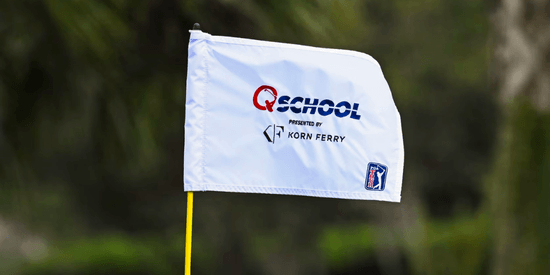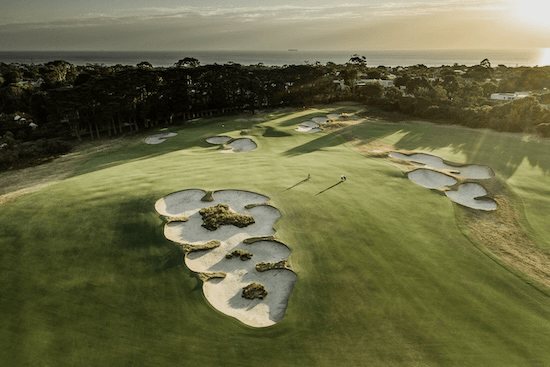At Casa de Campo, Guerra's growth aligns with LAAC spotlight
1/15/2019 | by Julie Williams of AmateurGolf.com
see also: Latin America Amateur Championship, Lima Golf Club

Juan Jose Guerra finally feels he has all the pieces to contend in his 5th start at the LAAC, to be played in his home country
In Juan Jose Guerra’s mind, there are two paths for a player: start hot and stall, or bloom late and flourish. Guerra likes to think of himself as being on the latter one, and those who know him agree.
Guerra will be a sort of unofficial host this week when the Latin America Amateur returns to Casa de Campo’s Teeth of the Dog course in La Romana, Dominican Republic, near Guerra's Santo Domingo home. He has played the course dozens of times over the past year and is ready to shake hands, sign autographs and rally his countrymen. At No. 241 in the World Amateur Golf Ranking, he carries the best ranking of the nine Dominican Republic players in the field.
It’s important to Guerra, 21, to represent his country in a positive way. Finally, a maturity level that makes him a real contender will collide with a home-country advantage. Guerra has played the LAAC every year since its 2015 debut, when he was just 17 years old. Last year’s tournament in Santiago, Chile was the first time he felt he had all the pieces.
“It’s a long week,” he explained. “Six days with interviews, a lot of people following you, it takes a toll out of you. In Chile, I felt like I was ready, my game was ready. I’ve been preparing for a while now for this event.”
In the five-year history of the Latin America Amateur, organized by the Masters Tournament, The R&A and the USGA, the Dominican Republic is the only country to repeat hosting duties. This is an event that players build their whole year around, as much for the depth of field as for the exposure. There are camera towers, ropes, signs and cameramen following you, if you’re lucky. There is a Masters invitation for the winner.
“It has that tour event vibe,” said Guerra, who embraces that kind of pressure.
To prepare for his fifth LAAC start, Guerra played two recent events on the Canita Tour, a mini-tour in the Dominican Republic. The senior at Nova Southeastern University (Ft. Lauderdale, Fla.) is the No. 11-ranked Division II player in the country by Golfstat. He was a semifinalist for the Jack Nicklaus Award last season.
Guerra’s golf life is a story of taking every opportunity and making the most out of it. His father Robert took up the game in 1997, the same year Guerra, who goes by J.J., was born. He’s been playing since he could walk.
“If it wasn’t for him, I wouldn’t be playing, I’m sure,” said Guerra, explaining that in the Dominican Republic, if you’re athletic you play baseball.
At first, Robert Guerra played Las Lagunas Country Club in Santo Domingo. Eventually the family got a membership at Santo Domingo Country Club, which is a 27-hole facility. Nine of the holes, a shorter nine, were more kid-friendly. It was a perfect place to learn the game.
Asked for an idol, or at least a player who he would like to pattern his career after, Guerra gives two: Phil Mickelson and the late Arnold Palmer. Those being two of the most fan-conscious men in professional golf, there’s certainly a statement there about how Guerra sees his role in the game.
“In 2016 when the (LAAC) was here, I signed a few autographs,” Guerra said of the last time the event came to Casa de Campo.
That was the year that Guerra hit the tournament’s opening tee shot, “in front of all the green jackets and USGA people.” He had never felt so much like a Tour player…at least since the 2015 LAAC.
It was a very Palmer-esque moment on Guerra’s golf journey, which is maybe why he speaks so passionately about remembering where you came from and who provided you with opportunities along the way. The LAAC figures prominently into that conversation, but so does college golf.
Guerra is a constant reminder for his teammates that if you keep working hard, your growth can be exponential. He articulates that often to freshmen. Nova Southeastern perennially fields one of the top Division II golf teams in the nation, and as a junior golfer, Guerra’s game wasn’t quite there. He committed to golf full-time during his final year in high school, moving to Orlando to be more golf-immersed.
Four years later, as Guerra enters the final semester of his college career, he commands the most respect on the team not because he’s vocal, but because he can play.
Nova Southeastern head coach Joey Marino describes a self-awareness about Guerra that likely comes from being a late bloomer. But it’s one thing to know about a weakness and another thing entirely to have the discipline to work on it.
“Anyone can stand on the range and beat balls,” Marino said. “He’ll evaluate himself after a golf tournament and then work on what he needs to work on to get ready for the next event. He does a great job of approaching his practice that way.”
The improvement that Guerra has experienced, from Golfstat’s 31-ranked player after his freshman season to his current position at No. 11, is largely due to his short game.
“He’s one of those guys, as you watch him play – it’s easy to say that about elite players – but if he’s putting well that week, he can shoot anything,” Marino said.
Guerra’s story is exactly the kind that needed the LAAC spotlight to shine on it. He can’t name a player from the Dominican Republic who has played on the Web.com Tour of PGA Tour. Perhaps he'll be the first.
“It’s just growing,” Guerra said of his sport. “People are starting to take notice.”
Guerra will be a sort of unofficial host this week when the Latin America Amateur returns to Casa de Campo’s Teeth of the Dog course in La Romana, Dominican Republic, near Guerra's Santo Domingo home. He has played the course dozens of times over the past year and is ready to shake hands, sign autographs and rally his countrymen. At No. 241 in the World Amateur Golf Ranking, he carries the best ranking of the nine Dominican Republic players in the field.
It’s important to Guerra, 21, to represent his country in a positive way. Finally, a maturity level that makes him a real contender will collide with a home-country advantage. Guerra has played the LAAC every year since its 2015 debut, when he was just 17 years old. Last year’s tournament in Santiago, Chile was the first time he felt he had all the pieces.
“It’s a long week,” he explained. “Six days with interviews, a lot of people following you, it takes a toll out of you. In Chile, I felt like I was ready, my game was ready. I’ve been preparing for a while now for this event.”
“It has that tour event vibe,” said Guerra, who embraces that kind of pressure.
To prepare for his fifth LAAC start, Guerra played two recent events on the Canita Tour, a mini-tour in the Dominican Republic. The senior at Nova Southeastern University (Ft. Lauderdale, Fla.) is the No. 11-ranked Division II player in the country by Golfstat. He was a semifinalist for the Jack Nicklaus Award last season.
Guerra’s golf life is a story of taking every opportunity and making the most out of it. His father Robert took up the game in 1997, the same year Guerra, who goes by J.J., was born. He’s been playing since he could walk.
“If it wasn’t for him, I wouldn’t be playing, I’m sure,” said Guerra, explaining that in the Dominican Republic, if you’re athletic you play baseball.
At first, Robert Guerra played Las Lagunas Country Club in Santo Domingo. Eventually the family got a membership at Santo Domingo Country Club, which is a 27-hole facility. Nine of the holes, a shorter nine, were more kid-friendly. It was a perfect place to learn the game.
Asked for an idol, or at least a player who he would like to pattern his career after, Guerra gives two: Phil Mickelson and the late Arnold Palmer. Those being two of the most fan-conscious men in professional golf, there’s certainly a statement there about how Guerra sees his role in the game.
“In 2016 when the (LAAC) was here, I signed a few autographs,” Guerra said of the last time the event came to Casa de Campo.
That was the year that Guerra hit the tournament’s opening tee shot, “in front of all the green jackets and USGA people.” He had never felt so much like a Tour player…at least since the 2015 LAAC.
It was a very Palmer-esque moment on Guerra’s golf journey, which is maybe why he speaks so passionately about remembering where you came from and who provided you with opportunities along the way. The LAAC figures prominently into that conversation, but so does college golf.
Guerra is a constant reminder for his teammates that if you keep working hard, your growth can be exponential. He articulates that often to freshmen. Nova Southeastern perennially fields one of the top Division II golf teams in the nation, and as a junior golfer, Guerra’s game wasn’t quite there. He committed to golf full-time during his final year in high school, moving to Orlando to be more golf-immersed.
Nova Southeastern head coach Joey Marino describes a self-awareness about Guerra that likely comes from being a late bloomer. But it’s one thing to know about a weakness and another thing entirely to have the discipline to work on it.
“Anyone can stand on the range and beat balls,” Marino said. “He’ll evaluate himself after a golf tournament and then work on what he needs to work on to get ready for the next event. He does a great job of approaching his practice that way.”
The improvement that Guerra has experienced, from Golfstat’s 31-ranked player after his freshman season to his current position at No. 11, is largely due to his short game.
“He’s one of those guys, as you watch him play – it’s easy to say that about elite players – but if he’s putting well that week, he can shoot anything,” Marino said.
Guerra’s story is exactly the kind that needed the LAAC spotlight to shine on it. He can’t name a player from the Dominican Republic who has played on the Web.com Tour of PGA Tour. Perhaps he'll be the first.
“It’s just growing,” Guerra said of his sport. “People are starting to take notice.”
Most Popular Articles

2025 PGA TOUR Q-School Guide: Sites, Scores, and Who Advanced
Dec 5, 2025Second Stage is complete and Final Stage awaits at Sawgrass — follow every Q-School leaderboard and the players still chasing
2025 LPGA TOUR Q-Series: Final Qualifying Stage FINAL SCORING
Dec 8, 2025Helen Briem earns medalist honors, 31 players headed to the LPGA next year
2025 PGA TOUR Q-School Final Stage: Ewart Leads Five New TOUR Card Winners
Dec 14, 2025A.J. Ewart topped Final Stage at TPC Sawgrass, leading five players who secured PGA TOUR membership for 2026.
Australian Open at Royal Melbourne: Preview, amateur bios, and how to watch
Nov 30, 2025Rory McIlroy headlines one of the championship's top fields in years - at least four amateurs will have their chance at gloryInside Gil Hanse’s Restoration of Baltusrol’s Upper Course: A Return to Tillinghast’s
Dec 11, 2025Renowned architect Gil Hanse reveals how he brought Baltusrol’s Upper Course back to life by honoring A.W. Tillinghast’s originalLoading latest news...
